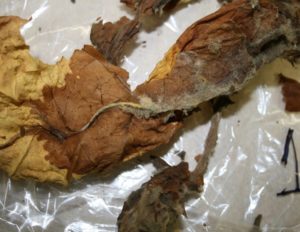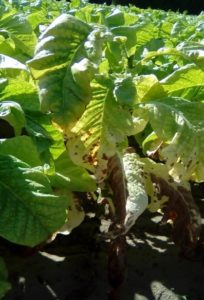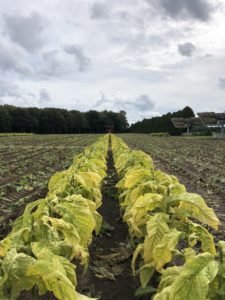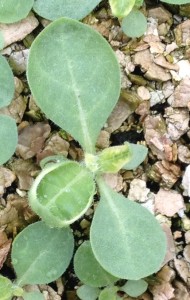Harvesting is almost finished with the majority of fields, however the remaining fields may need up to another week or more to finish harvest. The past few days have been characterized by rainy conditions and cooler nighttime temperatures that near frost temperatures.
Over the harvest season, fungal Pole Rot (causal organism Rhizopus arrhizus) (Figure 1), Aspergillus (causal organism Aspergillus spp) (Figure 2) and Bacterial Soft Rot (causal organism Erwinia carotovora) were the main problems encountered by growers. Tobacco scrap infested with Pole Rot or Aspergillus should not be spread on any fields used to grow tobacco. The infested scrap should be burned. Check with your local municipality regarding burning bylaws.
Any infested tobacco debris left in empty kilns and bins should be removed and destroyed as well. Disinfecting kilns, bins and pins before using them again next season should also be undertaken in those situations where Pole Rot and Aspergillus were an issue this year.
For more detailed information about fungal Pole Rot, please refer to the technical bulletins posted in the Plant Protection area of this website.
Bacterial Soft Rot infection starts in the field (Figure 3) and overcast weather with wet conditions favour bacterial spread. The disease develops during yellowing stages of tobacco curing and typically starts in the midrib of the leaf and quickly spreads through the veins, causing a dark brown or black discolouration of the veins and adjacent leaves (Figure 4). If allowed to spread, entire leaves rot and emit a foul odour. To minimize Bacterial Soft Rot damage, rogue out disease plants in the field, avoid harvesting or suckering tobacco in the rain and don’t load infected leaves into the kiln.
Similar to the past several years, there were no reports of Blue Mold in the Ontario Tobacco Crop in 2018.
The CTRF has now completed harvesting all variety and protection trials for 2018. These trials are conducted in cooperation with growers on several farms. This year there were a total of 46 promising flue-cured varieties being tested in replicated trials, with some of these varieties being grown at multiple sites. The protection program has focused on evaluating potential products for control of nematodes and fungi that can impact tobacco.
Post prepared and sent by Canadian Tobacco Research Foundation
Mailing Address: CTRF, P.O. Box 322, Tillsonburg, ON N4G 4H5
Telephone: 519-842-8997
Web Address: http://ctrf1.com













